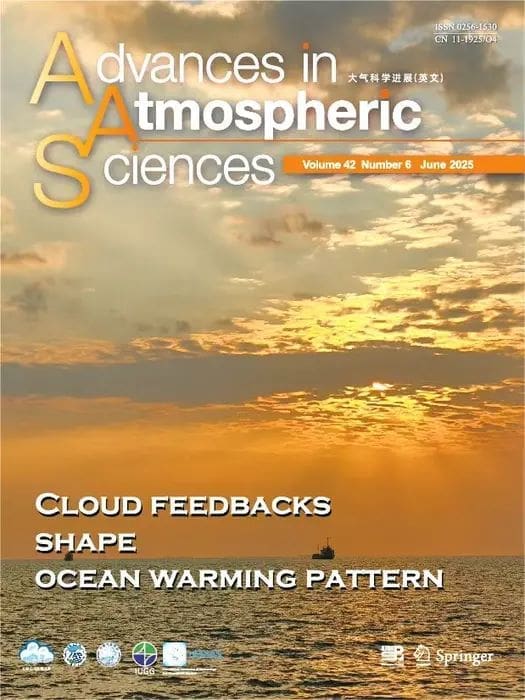Summary:
Climate models differ in their projections of sea surface temperature (SST) changes in the tropical Pacific, a key region influencing global climate. A study published in Advances in Atmospheric Sciences reveals that cloud–radiation feedback is the primary driver of these discrepancies.
Using data from 30 Coupled Model Intercomparison Project Phase 6 (CMIP6) models, researchers from China and the UK found that cloud-related processes in the eastern and central Pacific shape how warming patterns develop. In the eastern Pacific, variations in cloud–radiation feedback lead to different intensities of El Niño-like warming, making it the largest source of uncertainty among models. Meanwhile, in the central Pacific, underestimated negative cloud–radiation feedback, along with ocean–atmosphere interactions, contributes to stronger projected warming in the western Pacific than the multi-model average.
The findings suggest that the real-world tropical Pacific may experience even stronger El Niño-like warming than current models predict, potentially intensifying climate extremes such as storms and droughts. Scientists aim to refine future projections to resolve discrepancies between observed SST trends and climate model simulations.
Cloud–radiation feedbacks found to be key to the diverse tropical pacific warming projections

New research has uncovered why different climate models offer varying projections of sea surface temperature (SST) changes in the tropical Pacific, a region critical for global climate patterns. The study, identifies cloud–radiation feedback as the dominant source behind these differences.
Reliable projections of the tropical Pacific SST warming (TPSW) pattern are crucial for understanding how global climate will change in a warming world. While the latest climate models from the Coupled Model Intercomparison Project Phase 6 (CMIP6) generally project an El Niño-like warming pattern — characterized by a weakening of the zonal SST gradient between the eastern and western tropical Pacific — the intensity of such weakening varies significantly across models.
Using advanced statistical techniques and heat budget analysis, researchers from China and the UK analyzed data from 30 CMIP6 models. They discovered that the diversity in projecting TPSW patterns stems from two distinct cloud–radiation feedbacks:
- Eastern Pacific: Different cloud–radiation feedback over the eastern Pacific drive varying magnitudes of El Niño-like warming. This is the leading source of uncertainty in the projected TPSW among models, particularly in the far eastern equatorial Pacific.
- Central Pacific: Different negative cloud–radiation feedback over the central Pacific, coupled with ocean–atmosphere interactions including the wind–evaporation–SST (WES) feedback and the Bjerknes feedback, determines the different warming in the western Pacific. Most models underestimate this negative feedback, resulting in projections of stronger warming in the western Pacific than the multi-model average.
“These findings highlight the critical role of cloud–radiation feedback in shaping how different climate models project future warming patterns in the tropical Pacific,” said Dr. Jun Ying, lead author of the study, from Second Institute of Oceanography, Ministry of Natural Resources, China. “Unraveling these mechanisms brings us closer to producing more reliable climate projections.”
The study warns that the underestimated negative cloud–radiation feedback in models could mean the real-world tropical Pacific in the future will exhibit even stronger El Niño-like warming than currently projected, which is associated with more severe climate extremes, such as intense storms and prolonged droughts, underscoring the importance of improving climate model projections.
“Previous studies have identified the ‘pattern effect’ as being important in modifying the magnitude of different climate feedbacks, but here we consider climate feedbacks as being important in shaping the patterns of SST change. Moreover, this is one of the first to consider low-cloud feedbacks as being important in shaping the patterns of SST change” said Prof. Matthew Collins, one of the corresponding authors, from the University of Exeter, UK.
A major challenge lies in reconciling the observed long-term SST trend, which suggests a La Niña-like warming (enhanced west-minus-east SST gradient), with the El Niño-like pattern projected by CMIP6 models. The research team aims to resolve this discrepancy in a next study.
“Our ultimate goal is to refine model projections of the tropical Pacific SST warming pattern, providing a more convincing basis for estimating future climate changes” Dr. Ying added.
Journal Reference:
Ying, J., Collins, M., Chadwick, R. et al., ‘Causes of Differences in the Tropical Pacific SST Warming Pattern Projected by CMIP6 Models’, Advances in Atmospheric Sciences (2025). DOI: 10.1007/s00376-024-4278-4
Article Source:
Press Release/Material by Institute of Atmospheric Physics | Chinese Academy of Sciences
Featured image credit: wirestock | Freepik




